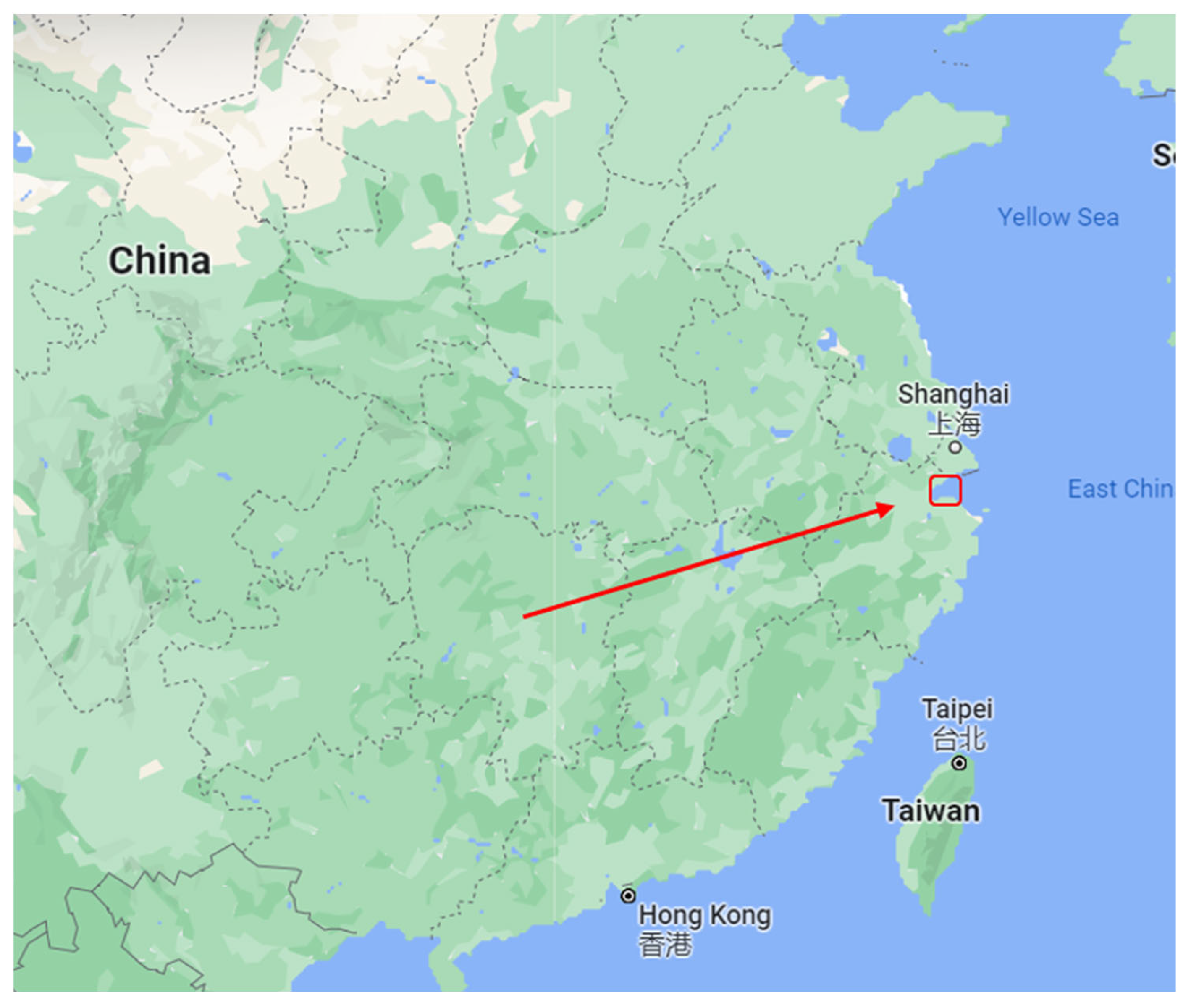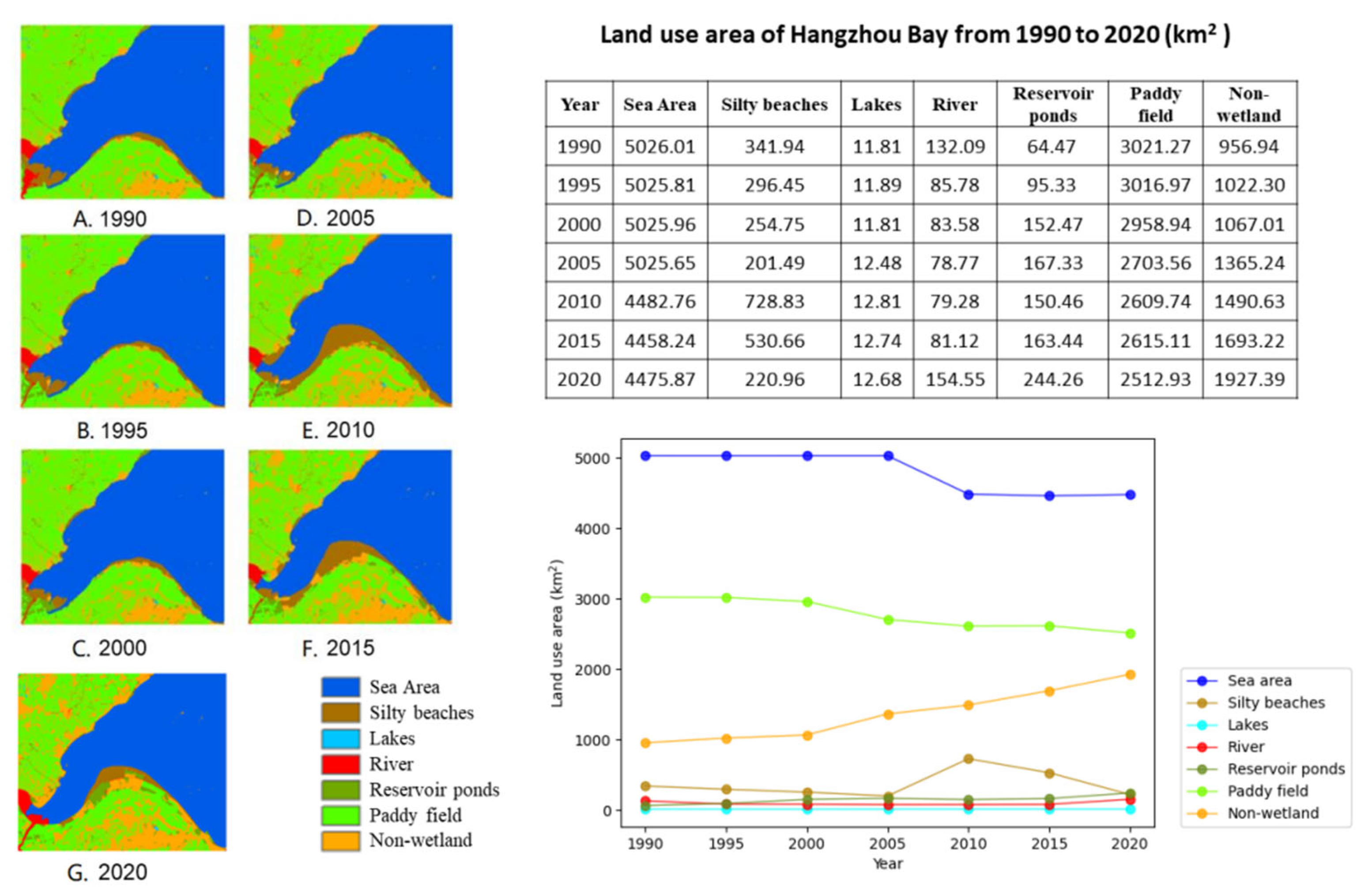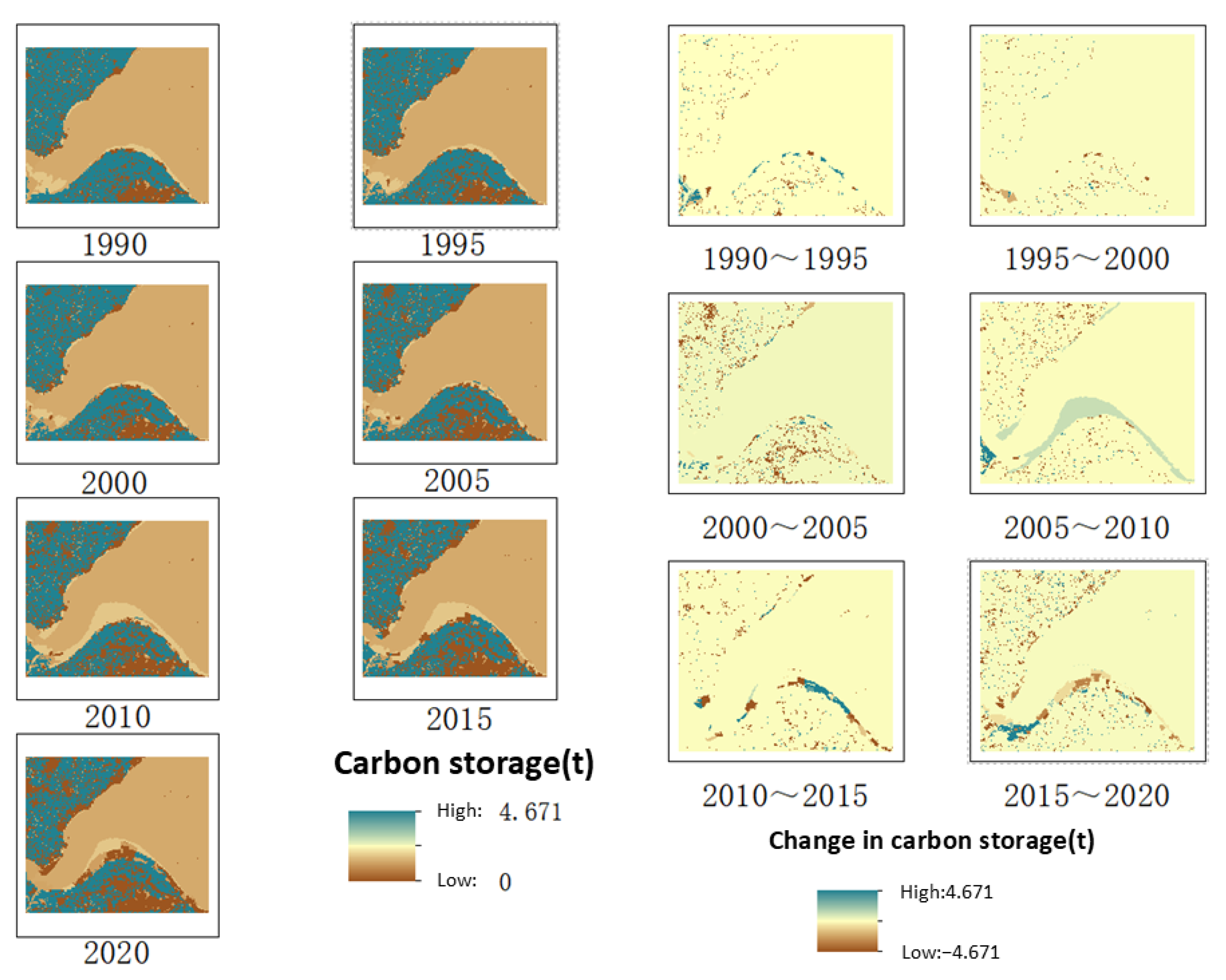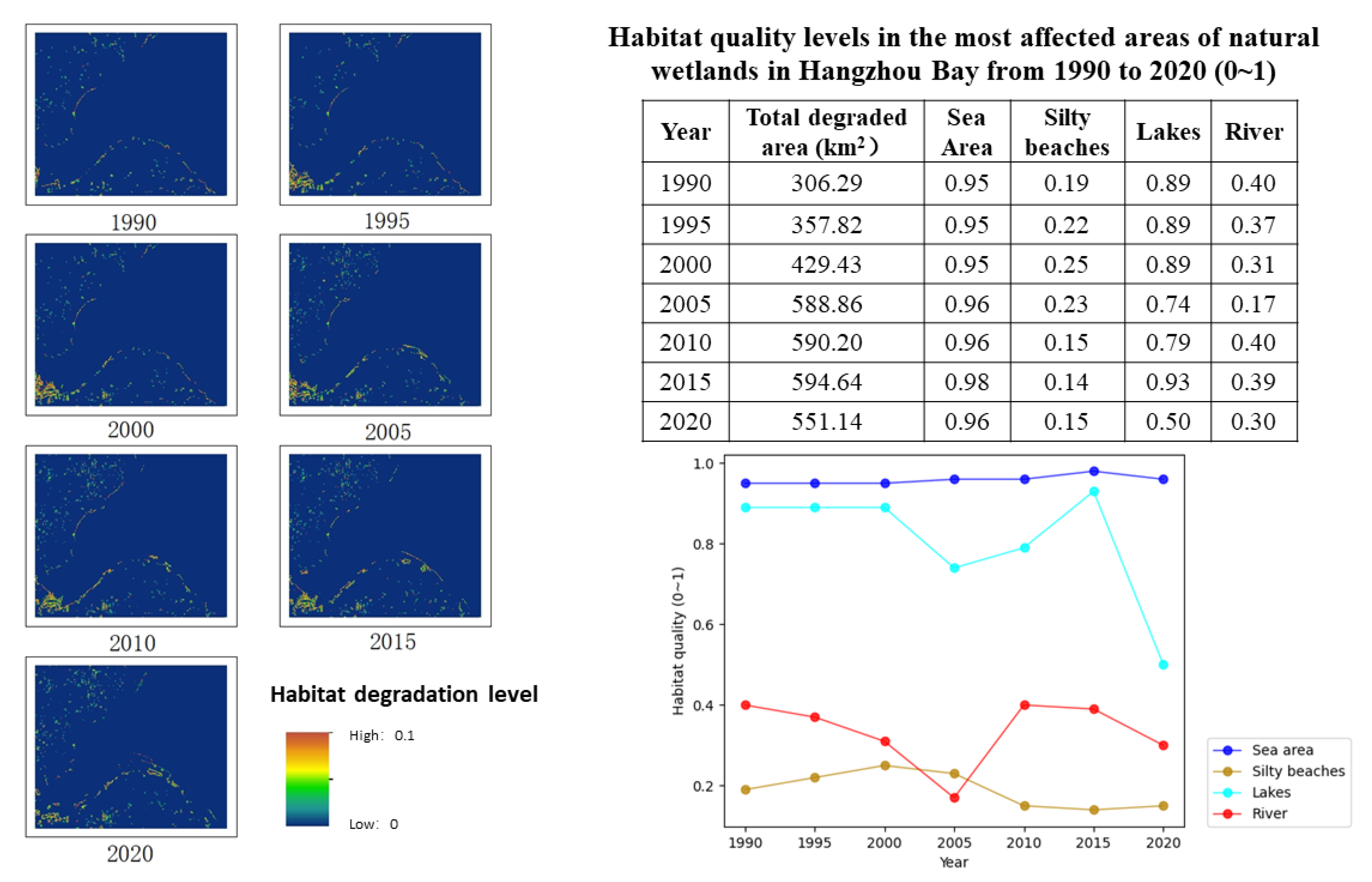Long-Term Spatiotemporal Changes in Ecosystem Services Caused by Coastal Wetland Type Transformation in China’s Hangzhou Bay
Abstract
:1. Introduction
2. Materials and Methods
2.1. Study Area
2.2. Data Source and Processing
2.3. Methods
2.3.1. Land-Use Change
2.3.2. Carbon Storage
2.3.3. Annual Water Output
2.4. Habitat Quality
3. Results
3.1. Land-Use/Cover Change
3.2. Changes in Transfer between Wetland Types
3.3. Changes in Carbon Storage
3.4. Changes in Annual Water Yield
3.5. Changes in Habitat Quality
4. Discussion
5. Conclusions
Author Contributions
Funding
Institutional Review Board Statement
Informed Consent Statement
Data Availability Statement
Acknowledgments
Conflicts of Interest
References
- Costanza, R.; d’Arge, R.; de Groot, R.; Farber, S.; Grasso, M.; Hannon, B.; Limburg, K.; Naeem, S.; O’Neil, R.V.; Paruelo, J.; et al. The Value of the World’s Ecosystem Services and Natural Capital. Nature 1997, 387, 253–260. [Google Scholar] [CrossRef]
- Narayan, S.; Beck, M.W.; Wilson, P.; Thomas, C.J.; Guerrero, A.; Shepard, C.C.; Reguero, B.G.; Franco, G.; Ingram, J.C.; Trespalacios, D. The Value of Coastal Wetlands for Flood Damage Reduction in the Northeastern USA. Sci. Rep. 2017, 7, 9463. [Google Scholar] [CrossRef] [PubMed] [Green Version]
- Davidson, N.C.; van Dam, A.A.; Finlayson, C.M.; McInnes, R.J. Worth of Wetlands: Revised Global Monetary Values of Coastal and Inland Wetland Ecosystem Services. Mar. Freshw. Res. 2019, 70, 1189–1194. [Google Scholar] [CrossRef]
- Xiao, N.; Mimi, H.; Xuexin, S.; Ming, W. Assessment of Ecological Service Functions of Coastal Wetlands on the South Bank of Hangzhou Bay. Ecol. Sci. 2017, 36, 166–176. [Google Scholar] [CrossRef]
- Yingjun, F.; Yan, L.; Qinchun, X.; Liren, Z. Geomorphology of Hangzhou Bay and the activity of the sedimentary interface. J. Oceanogr. 1990, 12, 11. [Google Scholar]
- Yang, S.; Guo, S. Analysis of the climatic characteristics of Hangzhou Bay area. East China Sea Mar. 1985, 4, 16–26. [Google Scholar]
- Li, L. Research on Remote Sensing Monitoring and Change of Vegetation Cover along Hangzhou Bay. Master’s Thesis, Shanghai Normal University, Shang Hai, China, 2015. [Google Scholar]
- Zhou, X. Study on the Economic and Industrial Development of the Hangzhou Bay Rim. Econ. Perspect. Next 2012, 5, 4. [Google Scholar]
- Chenwei, D.; Yu, C.; Yongzhong, T. Urban sprawl and vegetation change around Hangzhou Bay based on nighttime lighting data. J. Appl. Ecol. 2017, 28, 8. [Google Scholar]
- Classification of Land Use Status; China Land Survey and Planning Institute, and Department of Cadastral Management, Ministry of Land and Resources: Beijing, China, 2017.
- Liu, J.; Hu, T.; Pan, S.; Zhang, D.; Zhang, L.; Li, Y.; Li, M. A study on the distribution and changes of wetlands along the south coast of Hangzhou Bay during three periods since 2006. Wetl. Sci. 2018, 16, 502–508. [Google Scholar] [CrossRef]
- Liu, C.W. Ecological Response Analysis of Wetland Landscape Pattern Changes Based on Invest. Master’s Thesis, Zhejiang University, Hang Zhou Shi, China, 2014. [Google Scholar]
- Xi, Y.; Peng, S.; Liu, G.; Ducharne, A.; Ciais, P.; Prigent, C.; Li, X.; Tang, X. Trade-Off between Tree Planting and Wetland Conservation in China. Nat. Commun. 2022, 13, 1–11. [Google Scholar] [CrossRef]
- Weisscher, S.A.H.; Baar, A.W.; van Belzen, J.; Bouma, T.J.; Kleinhans, M.G. Transitional Polders Along Estuaries: Driving Land-Level Rise and Reducing Flood Propagation. Nat. Based Solut. 2022, 2, 100022. [Google Scholar] [CrossRef]
- Zhang, L.; Cheng, L.; Chiew, F.; Fu, B. Understanding the Impacts of Climate and Landuse Change on Water Yield. Curr. Opin. Environ. Sustain. 2018, 33, 167–174. [Google Scholar] [CrossRef]
- Vigerstol, K.; Abell, R.; Brauman, K.; Buytaert, W.; Vogl, A. Addressing Water Security through Nature-Based Solutions. In Nature-Based Solutions and Water Security; Elsevier: Amsterdam, The Netherlands, 2021; pp. 37–62. [Google Scholar]
- Xu, L.; Nianpeng, H.; Guirui, Y. 2010s China Terrestrial Ecosystem Carbon Density Dataset. China Sci. Data Chin. Engl. Online 2019, 4, 7. [Google Scholar]
- Pan, Y.; Haijun, B.; Lingyan, H.; Jinxia, Z. The evolution of the spatiotemporal pattern of coastal urbanization in Zhejiang and its impact on habitat quality: A study based on the invest model. Shanghai Land Resour. 2020, 41, 7. [Google Scholar]
- Cai, M.; Lu, H.; Lijiao, Y. The temporal and spatial variation characteristics of annual water production in typical years in Hangzhou based on the invest model and its influencing factors. J. Zhejiang A&F Univ. 2022, 39, 9. [Google Scholar]
- Yang, Z.; Cifang, W.; Yong, L. Assessment of Wetland Vulnerability in Rapid Urbanization Areas—A Case Study of Hangzhou Bay Wetland. Resour. Sci. 2009, 31, 243–249. [Google Scholar]
- He, Q.; Bertness, M.D.; Bruno, J.F.; Li, B.; Chen, G.Q.; Coverdale, T.C.; Altieri, A.H.; Bai, J.; Sun, T.; Pennings, S.C.; et al. Economic Development and Coastal Ecosystem Change in China. Sci. Rep. 2014, 4, 5995. [Google Scholar] [CrossRef] [Green Version]
- Lin, Q.Y.; Yu, S. Losses of Natural Coastal Wetlands by Land Conversion and Ecological Degradation in the Urbanizing Chinese Coast. Sci. Rep. 2018, 8, 15046. [Google Scholar] [CrossRef]
- Costanza, R.; Groot, R.D.; Sutton, P.; van der Ploeg, S.; Anderson, S.J.; Kubiszewski, I.; Farber, S.; Turner, R.K. Changes in the Global Value of Ecosystem Services; Elsevier: Amsterdam, The Netherlands, 2014. [Google Scholar]
- Camacho-Valdez, V.; Ruiz-Luna, A.; Ghermandi, A.; Berlanga-Robles, C.A.; Nunes, P. Effects of Land Use Changes on the Ecosystem Service Values of Coastal Wetlands. Environ. Manag. 2014, 54, 852–864. [Google Scholar] [CrossRef]
- Hein, L.; van Koppen, K.; de Groot, R.S.; van Ierland, E.C. Spatial Scales, Stakeholders and the Valuation of Ecosystem Services. Ecol. Econ. 2006, 57, 209–228. [Google Scholar] [CrossRef]
- Sharp, R.; Douglass, J.; WoIny, S.; Arkema, K.; Bernhardt, J.; Bierbower, W.; Chaumont, N.; Denu, D.; Fisher, D.; Glowinski, K.; et al. InVEST 3.10.2.post52+ug.g49d06a1 User’s Guide; University of Minnesota, The Nature Conservancy, and World Wildlife Fund: Minneapolis, MN, USA, 2020; Available online: https://storage.googleapis.com/releases.naturalcapitalproject.org/invest-userguide/latest/index.html (accessed on 16 September 2022).
- Zhang, Z.; Liu, F.; Zhao, X.; Wang, X.; Shi, L.; Xu, J.; Yu, S.; Wen, Q.; Zuo, L.; Yi, L.; et al. Urban Expansion in China Based on Remote Sensing Technology: A Review. Chin. Geogr. Sci. 2018, 28, 727–743. [Google Scholar] [CrossRef] [Green Version]
- Wetland Protection Law of the People’s Republic of China. Bull. Standing Comm. Natl. People’s Congr. People’s Repub. China 2022, 1, 21–28.
- Sun, Z.G.; Sun, W.G.; Tong, C.; Zeng, C.S.; Yu, X.; Mou, X.J. China’s Coastal Wetlands: Conservation History, Implementation Efforts, Existing Issues and Strategies for Future Improvement. Environ. Int. 2015, 79, 25–41. [Google Scholar] [CrossRef] [PubMed]
- Ouyang, Z.; Zheng, H.; Xiao, Y.; Polasky, S.; Liu, J.; Xu, W.; Wang, Q.; Zhang, L.; Xiao, Y.; Rao, E.; et al. Improvements in Ecosystem Services from Investments in Natural Capital. Science 2016, 352, 1455–1459. [Google Scholar] [CrossRef] [PubMed]






| Land Kind | Land Use | Description of the Type of Land |
|---|---|---|
| Natural wetlands | Sea area | Offshore waters where the water level is lower than 6 m at low tide |
| Silty beaches | Muddy shoals and various marshy areas on the coast | |
| Lakes | Freshwater lakes and lakeside wetlands with an area of more than 8 ha | |
| River | Linear waterways on land surfaces, including streams and floodplains | |
| Artificial wetlands | Reservoir and pond | Including coastal reservoirs, agricultural ponds, storage ponds, and fish ponds |
| Paddy field | Land that can store water for growing aquatic crops, such as rice | |
| Non-wetlands | Non-wetlands | Excluding the above-mentioned land types, including urban and rural settlements, dry land, forest land, etc. |
| Wetland Type | Time Sub List | 1990~1995 | 1995~2000 | 2000~2005 | 2005~2010 | 2010~2015 | 2015~2020 | ||||||
|---|---|---|---|---|---|---|---|---|---|---|---|---|---|
| In | Out | In | Out | In | Out | In | Out | In | Out | In | Out | ||
| Sea area | Silty beaches | 0.10 | 0.13 | 0.13 | 0.09 | 0.08 | 0.19 | 0.05 | 543.01 | 0.08 | 13.35 | 21.26 | 1.78 |
| Lakes | 0.00 | 0.00 | 0.00 | 0.00 | 0.00 | 0.00 | 0.00 | 0.00 | 0.00 | 0.00 | 0.00 | 0.00 | |
| River | 0.00 | 0.00 | 0.00 | 0.00 | 0.01 | 0.00 | 0.00 | 0.01 | 0.00 | 0.14 | 0.15 | 0.30 | |
| Reservoir ponds | 0.00 | 0.00 | 0.00 | 0.01 | 0.01 | 0.07 | 0.01 | 0.05 | 0.00 | 5.31 | 0.24 | 0.70 | |
| Paddy field | 0.01 | 0.06 | 0.03 | 0.00 | 0.02 | 0.08 | 0.01 | 0.03 | 0.00 | 2.05 | 0.37 | 0.04 | |
| Non-wetland | 0.01 | 0.15 | 0.14 | 0.01 | 0.01 | 0.13 | 0.09 | 0.12 | 0.02 | 3.77 | 2.89 | 0.99 | |
| Total | 0.15 | 0.34 | 0.30 | 0.14 | 0.16 | 0.47 | 0.16 | 543.22 | 0.10 | 24.62 | 24.91 | 3.81 | |
| Silty beaches | Sea area | 0.13 | 0.10 | 0.09 | 0.13 | 0.19 | 0.08 | 543.01 | 0.05 | 13.35 | 0.08 | 1.78 | 21.26 |
| Lakes | 0.00 | 0.00 | 0.00 | 0.00 | 0.03 | 0.01 | 0.02 | 0.03 | 0.01 | 0.01 | 0.01 | 0.05 | |
| River | 13.19 | 2.87 | 0.06 | 0.01 | 0.12 | 0.11 | 0.13 | 0.16 | 0.09 | 1.83 | 0.03 | 62.13 | |
| Reservoir ponds | 2.16 | 18.26 | 0.01 | 37.30 | 0.08 | 29.83 | 0.19 | 7.23 | 0.04 | 28.10 | 0.03 | 91.87 | |
| Paddy field | 1.12 | 23.68 | 0.04 | 1.20 | 3.15 | 6.17 | 0.25 | 2.82 | 0.08 | 77.04 | 0.14 | 32.40 | |
| Non-wetland | 0.10 | 17.27 | 0.14 | 3.37 | 0.35 | 20.97 | 1.56 | 7.53 | 0.20 | 104.87 | 2.52 | 106.44 | |
| Total | 16.70 | 62.18 | 0.34 | 42.04 | 3.92 | 57.17 | 545.16 | 17.82 | 13.77 | 211.93 | 4.51 | 314.15 | |
| Lakes | Sea area | 0.00 | 0.00 | 0.00 | 0.00 | 0.00 | 0.00 | 0.00 | 0.00 | 0.00 | 0.00 | 0.00 | 0.00 |
| Silty beaches | 0.00 | 0.00 | 0.00 | 0.00 | 0.01 | 0.03 | 0.03 | 0.02 | 0.01 | 0.01 | 0.05 | 0.01 | |
| River | 0.00 | 0.00 | 0.00 | 0.00 | 0.00 | 0.00 | 0.00 | 0.00 | 0.00 | 0.00 | 0.00 | 0.00 | |
| Reservoir ponds | 0.00 | 0.00 | 0.00 | 0.02 | 0.00 | 0.00 | 0.01 | 0.01 | 0.01 | 0.00 | 0.00 | 0.02 | |
| Paddy field | 0.15 | 0.07 | 0.07 | 0.13 | 1.28 | 0.18 | 0.66 | 0.35 | 0.17 | 0.17 | 0.68 | 0.59 | |
| Non-wetland | 0.01 | 0.01 | 0.01 | 0.01 | 0.06 | 0.17 | 0.14 | 0.13 | 0.07 | 0.15 | 0.28 | 0.45 | |
| Total | 0.16 | 0.08 | 0.08 | 0.16 | 1.35 | 0.68 | 0.84 | 0.51 | 0.26 | 0.33 | 1.01 | 1.07 | |
| River | Sea area | 0.00 | 0.00 | 0.00 | 0.00 | 0.00 | 0.01 | 0.01 | 0.00 | 0.14 | 0.00 | 0.30 | 0.15 |
| Silty beaches | 2.87 | 13.19 | 0.04 | 0.06 | 0.11 | 0.12 | 0.16 | 0.13 | 1.83 | 0.09 | 62.13 | 0.03 | |
| Lakes | 0.00 | 0.00 | 0.00 | 0.00 | 0.00 | 0.00 | 0.00 | 0.00 | 0.00 | 0.00 | 0.00 | 0.00 | |
| Reservoir ponds | 0.33 | 13.03 | 0.01 | 1.95 | 0.05 | 2.52 | 0.13 | 0.31 | 0.02 | 0.04 | 0.40 | 3.48 | |
| Paddy field | 0.30 | 21.50 | 0.36 | 0.65 | 1.09 | 3.02 | 2.59 | 2.07 | 0.41 | 0.47 | 7.87 | 2.15 | |
| Non-wetland | 0.03 | 2.13 | 0.08 | 0.04 | 0.42 | 0.83 | 0.57 | 0.42 | 0.17 | 0.17 | 9.45 | 0.83 | |
| Total | 3.53 | 49.85 | 0.49 | 2.70 | 1.67 | 6.50 | 3.46 | 2.93 | 2.60 | 0.77 | 80.15 | 6.61 | |
| Reservoir ponds | Sea area | 0.00 | 0.00 | 0.01 | 0.00 | 0.07 | 0.01 | 0.05 | 0.01 | 5.31 | 0.00 | 0.70 | 0.24 |
| Silty beaches | 18.26 | 2.16 | 37.3 | 0.01 | 29.83 | 0.08 | 7.23 | 0.19 | 28.1 | 0.04 | 91.87 | 0.03 | |
| Lakes | 0.00 | 0.00 | 0.02 | 0.00 | 0.00 | 0.00 | 0.01 | 0.01 | 0.00 | 0.01 | 0.02 | 0.00 | |
| River | 13.03 | 0.33 | 1.95 | 0.01 | 2.52 | 0.05 | 0.31 | 0.13 | 0.04 | 0.02 | 3.48 | 0.40 | |
| Paddy field | 9.55 | 7.92 | 16.99 | 0.93 | 16.94 | 24.93 | 16.01 | 39.52 | 1.18 | 13.75 | 20.74 | 11.77 | |
| Non-wetland | 1.47 | 1.04 | 2.34 | 0.50 | 1.08 | 10.50 | 1.77 | 2.39 | 6.42 | 14.27 | 18.73 | 12.25 | |
| Total | 42.31 | 11.15 | 58.61 | 1.45 | 50.41 | 35.57 | 25.38 | 12.25 | 11.05 | 28.09 | 135.54 | 54.69 | |
| Paddy field | Sea area | 0.06 | 0.01 | 0.00 | 0.03 | 0.08 | 0.02 | 0.03 | 0.01 | 2.05 | 0.00 | 0.04 | 0.37 |
| Silty beaches | 23.68 | 1.12 | 1.20 | 0.04 | 6.17 | 3.15 | 2.82 | 0.25 | 77.04 | 0.08 | 32.40 | 0.14 | |
| Lakes | 0.07 | 0.15 | 0.13 | 0.07 | 0.48 | 1.28 | 0.35 | 0.66 | 0.17 | 0.17 | 0.59 | 0.68 | |
| River | 21.50 | 0.30 | 0.65 | 0.36 | 3.02 | 1.09 | 2.07 | 2.59 | 0.47 | 0.44 | 2.15 | 7.87 | |
| Reservoir ponds | 7.92 | 9.55 | 0.93 | 16.99 | 24.93 | 16.91 | 39.52 | 16.01 | 13.75 | 1.18 | 11.77 | 20.74 | |
| Non-wetland | 46.38 | 92.78 | 23.56 | 67.01 | 55.95 | 323.52 | 34.41 | 153.4 | 26.85 | 113.09 | 88.36 | 236.29 | |
| Total | 99.61 | 103.91 | 26.17 | 84.5 | 90.63 | 346.00 | 79.20 | 172.92 | 120.33 | 114.96 | 165.31 | 266.09 | |
| Non-wetland | Sea area | 0.15 | 0.04 | 0.04 | 0.14 | 0.13 | 0.04 | 0.12 | 0.09 | 3.77 | 0.02 | 0.99 | 2.89 |
| Silty beaches | 17.27 | 0.10 | 3.37 | 0.14 | 20.97 | 0.35 | 7.53 | 1.56 | 101.87 | 0.20 | 106.44 | 2.52 | |
| Lakes | 0.01 | 0.01 | 0.01 | 0.01 | 0.17 | 0.06 | 0.13 | 0.14 | 0.15 | 0.07 | 0.45 | 0.28 | |
| River | 2.13 | 0.03 | 0.04 | 0.08 | 0.83 | 0.42 | 0.42 | 0.57 | 0.17 | 0.17 | 0.83 | 9.45 | |
| Reservoir ponds | 1.04 | 1.47 | 0.50 | 2.34 | 10.50 | 1.08 | 2.39 | 1.77 | 14.27 | 6.42 | 12.25 | 18.73 | |
| Paddy field | 92.78 | 46.38 | 67.01 | 23.56 | 323.52 | 55.95 | 153.40 | 34.41 | 113.09 | 26.85 | 236.29 | 88.36 | |
| Total | 113.38 | 48.03 | 70.97 | 26.27 | 356.12 | 57.90 | 163.99 | 38.54 | 236.32 | 33.73 | 357.25 | 122.23 | |
| Year | 1990 | 1995 | 2000 | 2005 | 2010 | 2015 | 2020 |
|---|---|---|---|---|---|---|---|
| Land Use | |||||||
| Sea area | 703.64 | 703.61 | 703.63 | 703.59 | 627.58 | 624.14 | 626.62 |
| Silty beaches | 62.91 | 54.55 | 46.87 | 37.08 | 134.11 | 97.64 | 40.66 |
| Lakes | 1.54 | 1.55 | 1.54 | 1.63 | 1.67 | 1.66 | 1.65 |
| River | 17.17 | 11.15 | 10.87 | 10.25 | 10.30 | 10.55 | 20.09 |
| Reservoir pond | 8.08 | 11.94 | 19.08 | 20.95 | 18.85 | 20.47 | 30.53 |
| Paddy field | 1566.40 | 1564.15 | 1534.07 | 1401.63 | 1352.88 | 1355.79 | 1304.21 |
| Non-wetlands | 0.00 | 0.00 | 0.00 | 0.00 | 0.00 | 0.00 | 0.00 |
| Total volume | 2359.75 | 2346.95 | 2316.07 | 2175.13 | 2145.40 | 2110.24 | 2023.76 |
| Rate of change of total volume | −0.54% | −1.32% | −6.09% | −1.37% | −1.64% | −4.10% |
Publisher’s Note: MDPI stays neutral with regard to jurisdictional claims in published maps and institutional affiliations. |
© 2022 by the authors. Licensee MDPI, Basel, Switzerland. This article is an open access article distributed under the terms and conditions of the Creative Commons Attribution (CC BY) license (https://creativecommons.org/licenses/by/4.0/).
Share and Cite
Liang, H.; Chen, C.; Wang, K.; Ye, G. Long-Term Spatiotemporal Changes in Ecosystem Services Caused by Coastal Wetland Type Transformation in China’s Hangzhou Bay. J. Mar. Sci. Eng. 2022, 10, 1781. https://doi.org/10.3390/jmse10111781
Liang H, Chen C, Wang K, Ye G. Long-Term Spatiotemporal Changes in Ecosystem Services Caused by Coastal Wetland Type Transformation in China’s Hangzhou Bay. Journal of Marine Science and Engineering. 2022; 10(11):1781. https://doi.org/10.3390/jmse10111781
Chicago/Turabian StyleLiang, Haiji, Chong Chen, Kexin Wang, and Guanqiong Ye. 2022. "Long-Term Spatiotemporal Changes in Ecosystem Services Caused by Coastal Wetland Type Transformation in China’s Hangzhou Bay" Journal of Marine Science and Engineering 10, no. 11: 1781. https://doi.org/10.3390/jmse10111781
APA StyleLiang, H., Chen, C., Wang, K., & Ye, G. (2022). Long-Term Spatiotemporal Changes in Ecosystem Services Caused by Coastal Wetland Type Transformation in China’s Hangzhou Bay. Journal of Marine Science and Engineering, 10(11), 1781. https://doi.org/10.3390/jmse10111781







